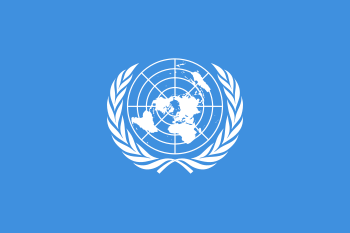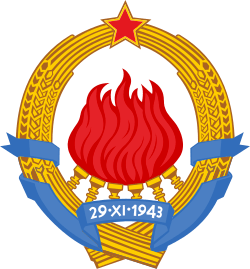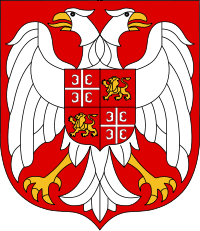Yugoslavia and the United Nations
 .svg.png) | |
| United Nations membership | |
|---|---|
| Represented by |
|
| Membership | Former full member |
| Dates | 24 October 1945 – 22 September 1992 |
| UNSC seat | Non-permanent |
 |
|---|
| This article is part of a series on the politics and government of Yugoslavia |
| Administrative divisions |
|
Foreign relations |
Yugoslavia was a charter member of the United Nations from its establishment in 1945 as the Socialist Federal Republic of Yugoslavia until 1992 during the Yugoslav Wars. It rejoined the UN under the Federal Republic of Yugoslavia in 2000 as a new member. Its seat was transferred to Serbia in 2006.
History
Federal People's Republic of Yugoslavia / Socialist Federal Republic of Yugoslavia (1945–1992)

Yugoslavia, joined the UN as an original member on 24 October 1945. It was not a part of the Warsaw Pact but pursued its own version of "Communism" under Marshal Josip Broz Tito. It was a multi-ethnic state which Tito was able to maintain through a doctrine of "Brotherhood and unity", but tensions between ethnicities began to escalate with the so-called Croatian Spring of 1970–71, a movement for greater Croatian autonomy, which was suppressed. In 1974 there followed constitutional changes, and the 1974 Yugoslav Constitution devolved some of the federal powers to the constituent republics and provinces. After Tito's death in 1980 ethnic tensions grew, first in Albanian-majority SAP Kosovo with the 1981 protests in Kosovo. In late 1980s Serbian leader Slobodan Milošević used the Kosovo crisis to stoke up Serb nationalism and attempt to consolidate and dominate the country, which alienated the other ethnic groups.
During 1990, the communists lost power to separatist parties in the first multi-party elections held across the country, except in Serbia and Montenegro, where they were won by Milošević and his allies. Nationalist rhetoric on all sides became increasingly heated. In 1991, one republic after another proclaimed independence (only Serbia and Montenegro remained federated), but the status of Serb minorities outside Serbia was left unsolved. After a string of inter-ethnic incidents, the Yugoslav Wars ensued, first in Croatia and then, most severely, in multi-ethnic Bosnia and Herzegovina; the wars left long-term economic and political damage in the region.
In November 1991, the Arbitration Commission of the Peace Conference on Yugoslavia, led by Robert Badinter, concluded at the request of Lord Carrington that the SFR Yugoslavia was in the process of dissolution, that the Serbian population in Croatia and Bosnia did not have a right to self-determination in the form of new states, and that the borders between the republics were to be recognized as international borders. As a result of the conflict, the United Nations Security Council unanimously adopted UN Security Council Resolution 721 on 27 November 1991, which paved the way to the establishment of the United Nations Protection Force in Yugoslavia.[1] In January 1992, Croatia and Yugoslavia signed an armistice under UN supervision, while negotiations continued between Serb and Croat leaderships over the partitioning of Bosnia and Herzegovina.[2]
On 15 January 1992, the independence of Croatia and Slovenia was recognized worldwide. By then, it had been effectively dissolved into five independent states, which were all subsequently admitted to the UN:
- Bosnia and Herzegovina, Croatia, and Slovenia were admitted to the UN on 22 May 1992.[3]
- Macedonia was admitted to the UN on 8 April 1993, being provisionally referred to for all purposes within the UN as "The former Yugoslav Republic of Macedonia" , due to pressure from Greece, pending settlement of the difference that had arisen over its name.[4]
Due to the dispute over its legal successor states, the member state "Yugoslavia", referring to the former Socialist Federal Republic of Yugoslavia, remained on the official roster of UN members for many years after its effective dissolution. Following the admission of all five states as new UN members, "Yugoslavia" was removed from the official roster of UN members.
Federal Republic of Yugoslavia / Serbia and Montenegro (2000–2006)
 .svg.png) | |
| United Nations membership | |
|---|---|
| Represented by |
|
| Membership | Former full member |
| Dates | 1 November 2000 – 3 July 2006 |
| Former name(s) | Yugoslavia (2000-2003) |
| UNSC seat | Non-permanent |
 |
|---|
| This article is part of a series on the politics and government of Serbia and Montenegro |
|
Constitution |
| Foreign relations |
|
Related topics |
The government of the Federal Republic of Yugoslavia, established on 28 April 1992 as a rump state by the remaining Yugoslav republics of Montenegro and Serbia,[5] claimed itself as the legal successor state of the former Socialist Federal Republic of Yugoslavia;[6] however, on 30 May 1992, United Nations Security Council Resolution 757 was adopted, by which it imposed international sanctions on the Federal Republic of Yugoslavia due to its role in the Yugoslav Wars, and noted that "the claim by the Federal Republic of Yugoslavia (Serbia and Montenegro) to continue automatically the membership of the former Socialist Federal Republic of Yugoslavia in the United Nations has not been generally accepted,"[7] and on 22 September 1992, United Nations General Assembly Resolution A/RES/47/1 was adopted, by which it considered that "the Federal Republic of Yugoslavia (Serbia and Montenegro) cannot continue automatically the membership of the former Socialist Federal Republic of Yugoslavia in the United Nations," and therefore decided that "the Federal Republic of Yugoslavia (Serbia and Montenegro) should apply for membership in the United Nations and that it shall not participate in the work of the General Assembly".[8][9] The Federal Republic of Yugoslavia refused to comply with the resolution for many years, but following the ousting of President Slobodan Milošević from office, it re-applied for membership, and was admitted to the UN on 1 November 2000 as a new member.[10] On 4 February 2003, the Federal Republic of Yugoslavia had its official name changed to Serbia and Montenegro, following the adoption and promulgation of the Constitutional Charter of Serbia and Montenegro by the Assembly of the Federal Republic of Yugoslavia.[11]
On the basis of a referendum held on 21 May 2006, Montenegro declared independence from Serbia and Montenegro on 3 June 2006. In a letter dated on the same day, the President of Serbia informed the United Nations Secretary-General that the membership of Serbia and Montenegro in the UN was being continued by Serbia, following Montenegro's declaration of independence, in accordance with the Constitutional Charter of Serbia and Montenegro.[12] Montenegro was admitted to the UN on 28 June 2006.[13]
See also
References
- ↑ "Resolution 721". N.A.T.O. 25 September 1991. Retrieved 21 July 2006.
- ↑ Lukic & Lynch 1996, p. 210.
- ↑ Paul L. Montgomery (23 May 1992). "3 Ex-Yugoslav Republics Are Accepted into U.N." The New York Times. Archived from the original on 29 July 2012. Retrieved 29 July 2012.
- ↑ Lewis, Paul (8 April 1993). "U.N. Compromise Lets Macedonia Be a Member". The New York Times.
- ↑ Burns, John F. (28 April 1992). "Confirming Split, Last 2 Republics Proclaim a Small New Yugoslavia". The New York Times.
- ↑ "History of Serbia: The Break-up of SFR Yugoslavia (1991–1995)". Serbia Info. Archived from the original on 22 December 2007.
- ↑ "United Nations Security Council Resolution 757" (PDF). United Nations.
- ↑ "United Nations General Assembly Resolution A/RES/47/1" (PDF). United Nations.
- ↑ Sudetic, Chuck (24 September 1992). "U.N. Expulsion of Yugoslavia Breeds Defiance and Finger-Pointing". The New York Times.
- ↑ "A Different Yugoslavia, 8 Years Later, Takes Its Seat at the U.N." The New York Times. 2 November 2000.
- ↑ "Yugoslavia consigned to history". BBC News. 4 February 2003.
- ↑ "World Briefing – Europe: Serbia: Going Solo". The New York Times. 6 June 2006.
- ↑ Schneider, Daniel B. (29 June 2006). "World Briefing – Europe: Montenegro: U.N. Makes It Official". The New York Times.
External links
- Official website of the Permanent Mission of Serbia to the UN
- Official website of the Ministry of Foreign Affairs of Serbia
| Wikimedia Commons has media related to Serbia and the United Nations. |